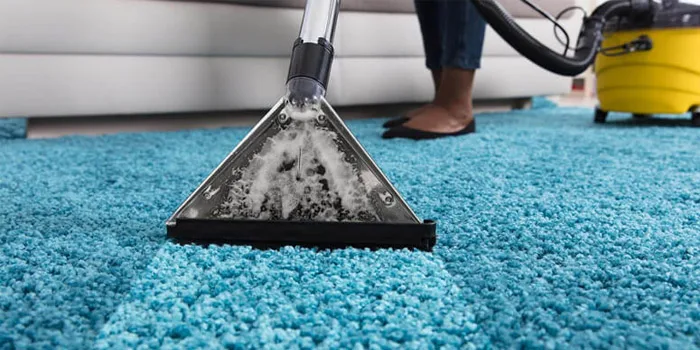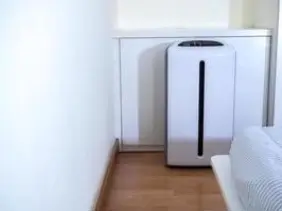Basements are a favorite spot for all types of fungus. Mold loves your basement because it’s dark, hot, and humid. These are the factors that lead to mold growth. All basements have an architectural flaw, they have poor ventilation and no sunlight. What do you expect in such a place? Mold!
Additionally, all the humidity from the living space gets trapped in the basement. This leads to many issues regarding health and indoor air quality. Go and check your basement today, it has mold growing everywhere.
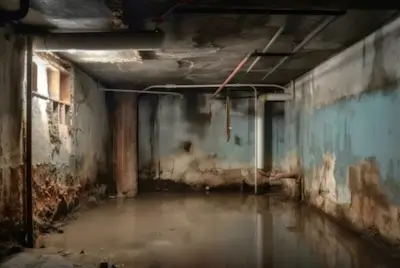
Can Mold in the Basement Affect Your Health?
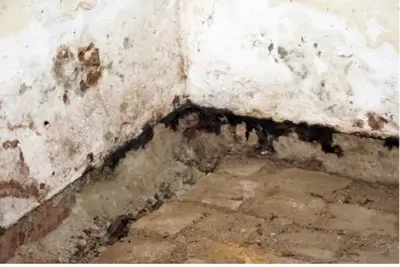
Yes, basement mold is just as dangerous as mold in your living space. You might think that the basement is a secluded part and does not affect your indoor air, but you’re wrong. Always remember that mold spores are microscopic and airborne. You cannot see them but they find their way into your living space through cracks, tiny holes, under the door, and even pipes.
Additionally, mold on the ceiling of your basement will eventually spread to your floors as well. But before it spreads that far, the airborne spores will start affecting your health. You can experience the following health issues due to mold in the basement:
- Asthma
- Lung Infection
- Skin Infection
- Runny Nose
- Chest Congestion
- Itchy, Red, Watery Eyes
- Throat Irritation
- Difficulty Breathing
- Sneezing
- Dizziness
- Nausea
Signs of Mold in Basement
What Causes Mold in Basement?
Since the basement is not a place you open frequently, seeing any signs of mold there is also a rarity. By the time you see the signs, the damage is already done. However, there are a few signs that can tell you that mold is growing in your basement.
- A damp or musty smell coming from the basement
- Damp Spots on the basement floors or ceiling
- Discoloration of the paint in the basement
- Water leaks in the basement
- Increased allergies in the house
- Stuffy air in the house
These are all signs that there’s a fungus growing silently in your basement. Additionally, if you see any water damage in the house or in the basement, check for mold.
As mentioned earlier, humidity, high temperature, and no sunlight are the core factors of mold in the basement. Some other factors contribute as well:
Water Leaks
A leaking pipe or a crack in the wall or floor can often cause water to get into your basement. This stagnant water becomes a factor for mold growth in the basement. Check for any sources of water seepage, faulty drainage pipes, or burst pipes.
Flooding
If your basement is not waterproof, it’s at a high risk of flooding during storms and heavy rainfall. A flooded basement will retain moisture in the floor and the walls. If you do not contact flood damage restoration in less than 24 hours, you are certainly allowing a healthy environment for mold growth in your basement.
Ceiling Leak
If the ceiling of the basement is directly under the floor of your kitchen, bathroom, or laundry, it’s a disaster. The excess moisture in the floors will allow moisture to travel to the basement ceiling. If there’s poor insulation or a leak in the pipes above the basement ceiling, this excess moisture will lead to mold in the basement.
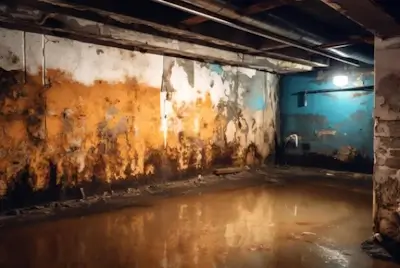 Malfunctioning Sump Pump
Malfunctioning Sump Pump
Another common cause of mold in your basement is the faulty sump pump. If the sump pump is not working properly, it will not pump water away from your home during a storm. As a result, the moisture will start building up in your basement and your walls. This will lead to issues like mold, bugs, and bacteria growth.
How to Kill Mold in Basement?
Mold in the basement is a serious problem for your health. You’re inhaling air that’s full of mold spores. It’s best to leave the job to professionals if the mold growth has affected a large area. If the area is small, wear protective gear before you do anything.
Ventilate the Basement
If your basement has an outer door or a window, open it for ventilation. If there’s no ventilation option, get an air suction duct and put its intake in the basement and the exhaust outdoors.
Dehumidify
If there’s no ventilation option, use a dehumidifier to remove excess air from the basement. Once the basement is dry, the spores will die but you will still have to remove visible mold.
Brush the Affected Area
Take a sturdy brush and scrub away all the visible mold from the affected area. Doing so will allow the cleaning agent to kill mold quickly.
Apply a Mold Killing Solution
Once all fuzzy textures are removed, prepare a cleaning solution and spray it onto the affected area generously. You can use the following:
- Borax
- Vinegar
- Hydrogen Peroxide
- Vinegar
- Bleach
- Commercial Mold Remover
Let the solution sit there for a few hours. Once it’s dry, Scrub once again and you’re good to go.
Run an Air Purifier and a Dehumidifier
Once you have removed the mold, run a dehumidifier for two to three hours to make sure there’s no moisture left. After you’ve dried out the basement, it’s important to run an air purifier to remove any scattered mold spores.
How to Prevent Basement Mold?
Although keeping your basement free of mold is a challenging task, there are still a few precautions that you can take:
- Keep your basement dry
- Do not store mold-damaged or damp objects in your basement
- Ventilate your basement or use a dehumidifier
- Keep an eye on water leaks, faulty sump pumps, burst pipes, and clogged drainage pipes.
- Make sure sewage water is not seeping into your basement walls or floors.
- Install proper insulation in the basement ceiling and around the vents, ducts, and pipes.
Conclusion
Mold in the basement is often a majorly overlooked issue in homes. Not only homes, but also offices and commercial buildings can fall prey to overlooked mold growth. This leads to air contamination and severe health issues. If you suspect any signs of mold in your basement, contact 24/7 Service Pros for effective and timely removal of mold. Prompt action will save your property and your health.
Which Areas We Serve in South Florida?
- Hollywood
- Davie
- Miami Beach
- Weston
- Hallandale Beach
- North Miami Beach
- Sunrise
- Tamarac
- Coconut Creek
- Fort Lauderdale
- Miami
- Boca Raton
- Hialeah
- Margate
- Pembroke Pines
- Dania Beach
- Lauderhill
- Delray Beach
- Pompano Beach
- Deerfield Beach
- Coral Springs
- Plantation
- Doral
- Aventura
- Miramar
- Sunny Isles Beach

